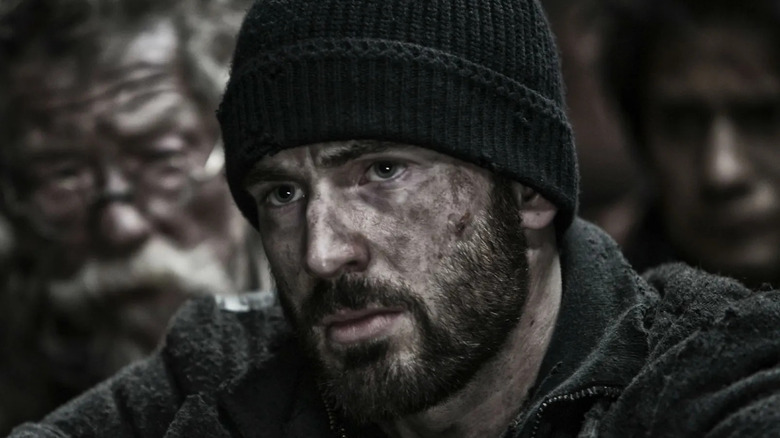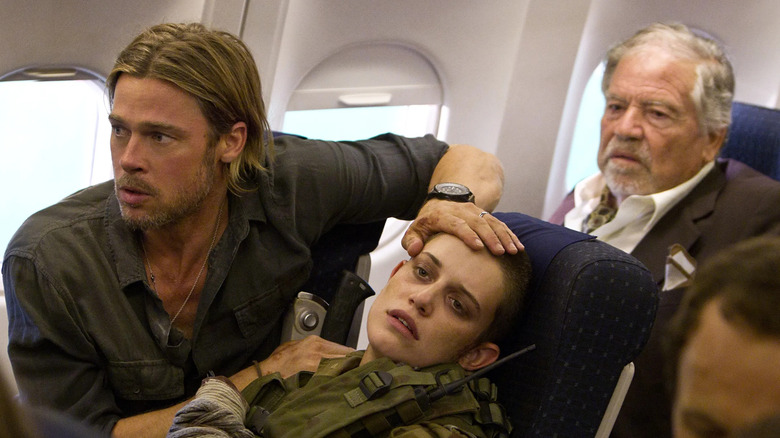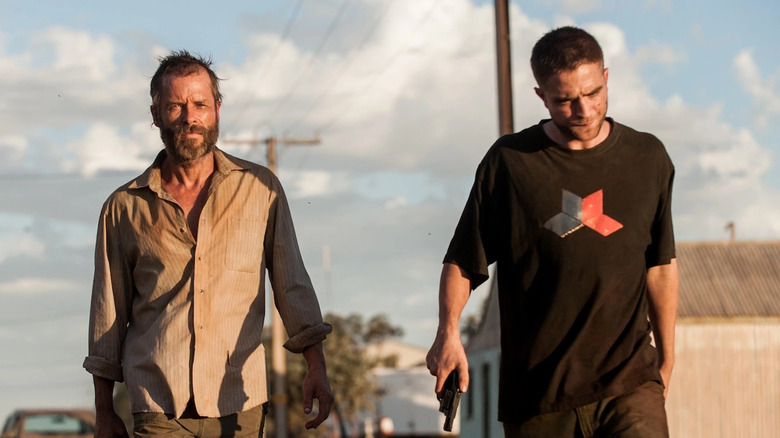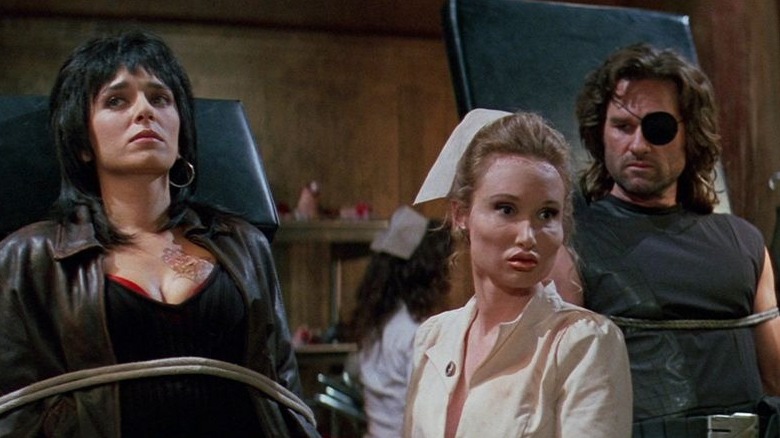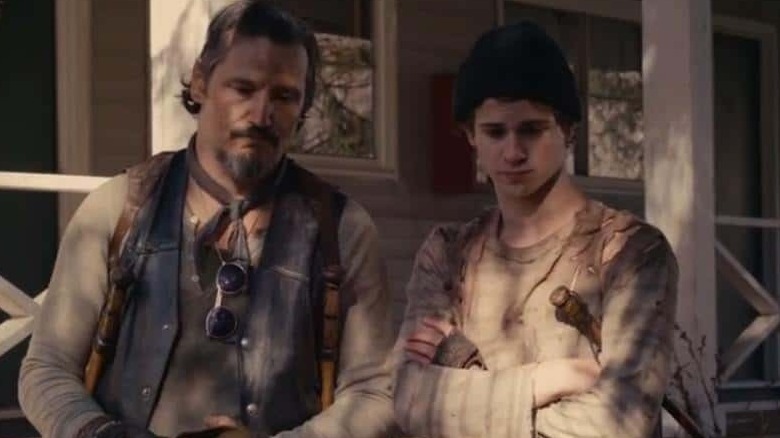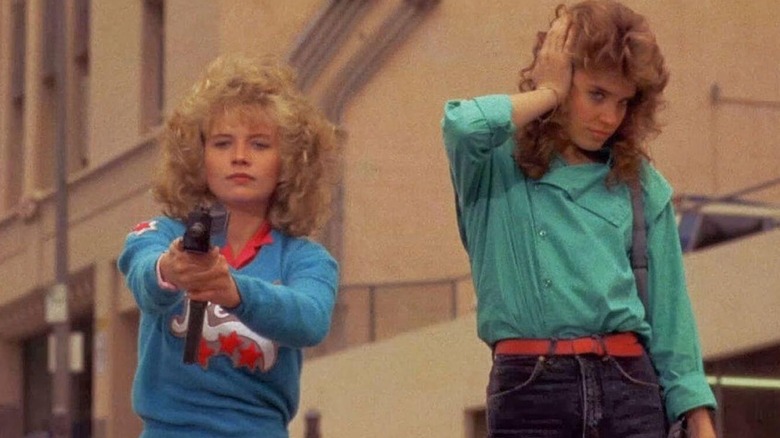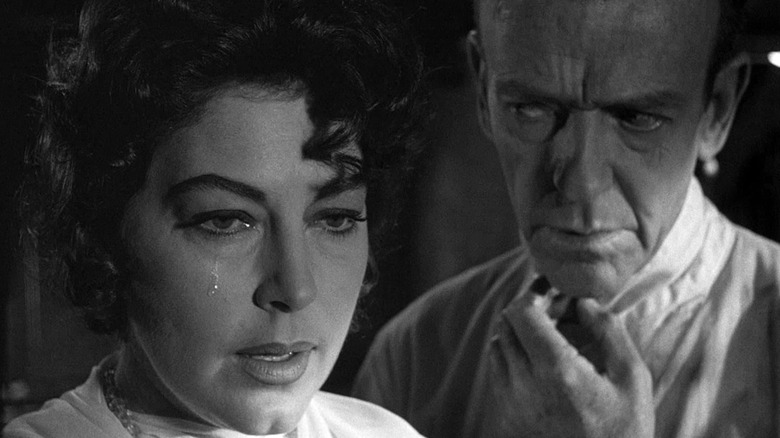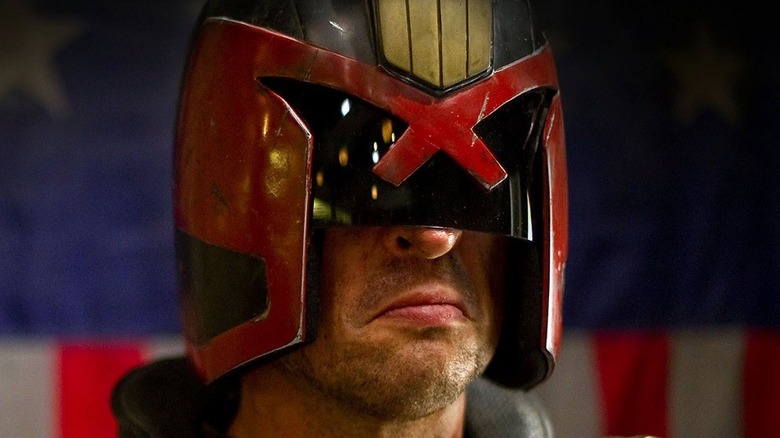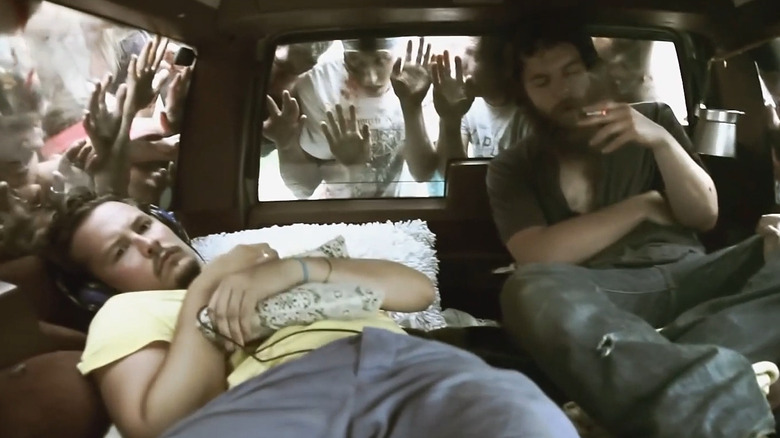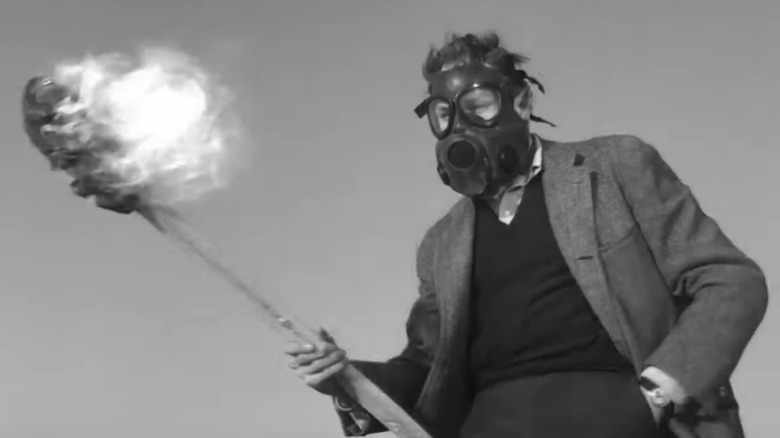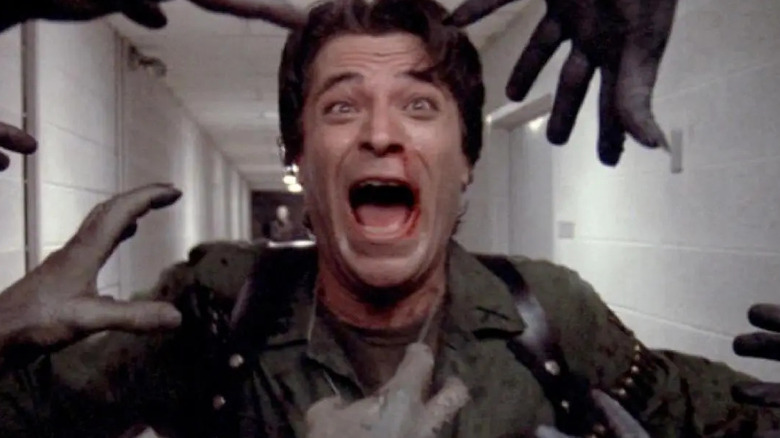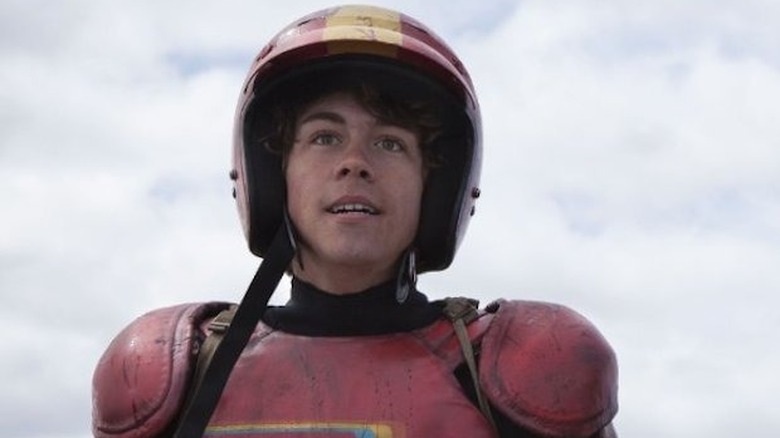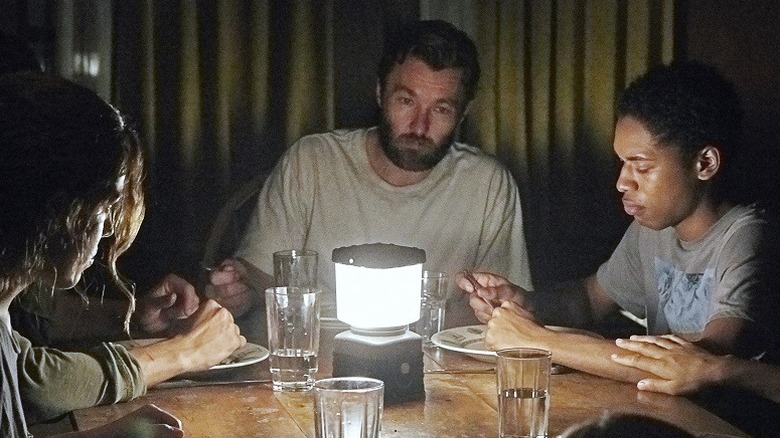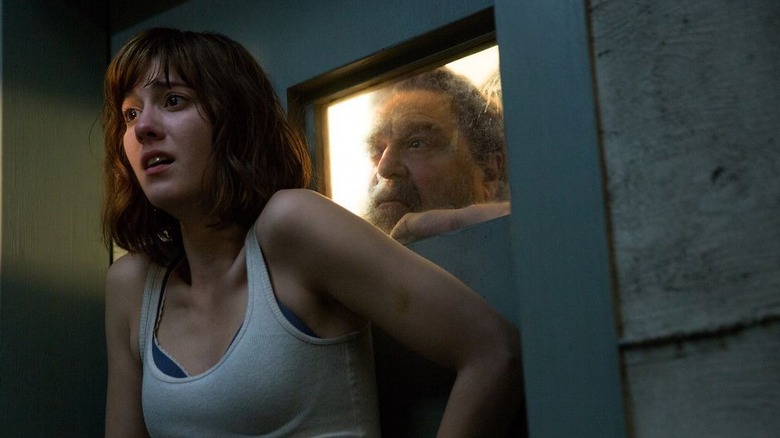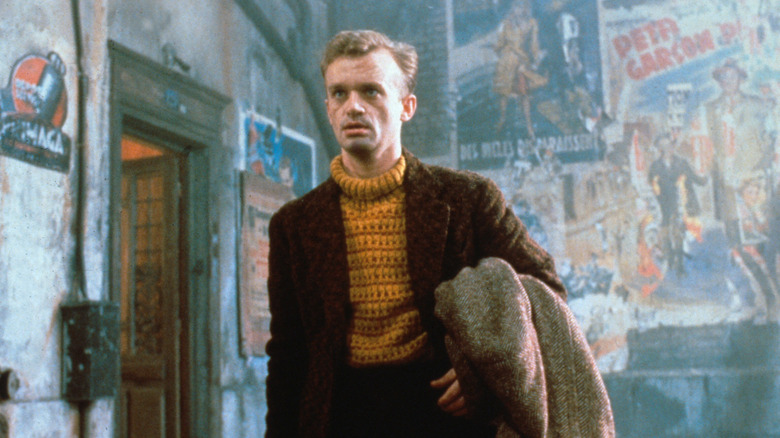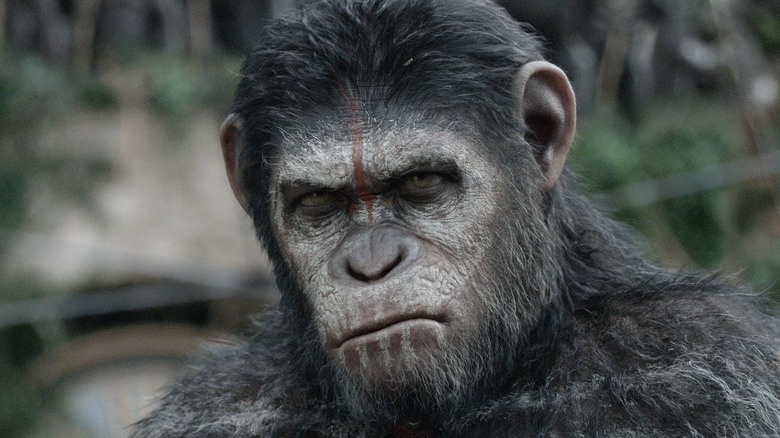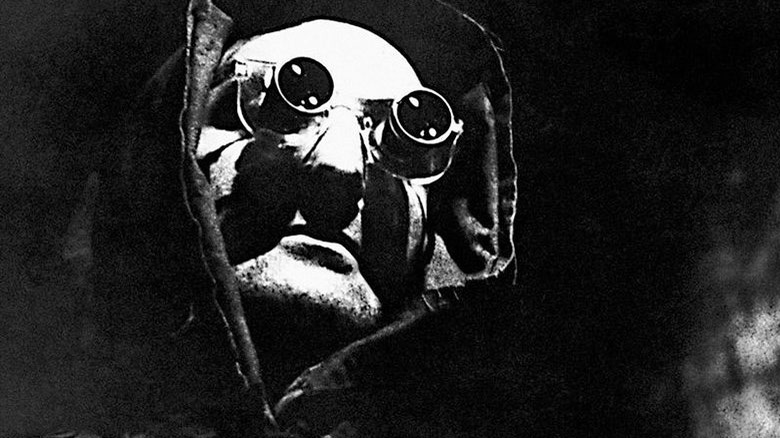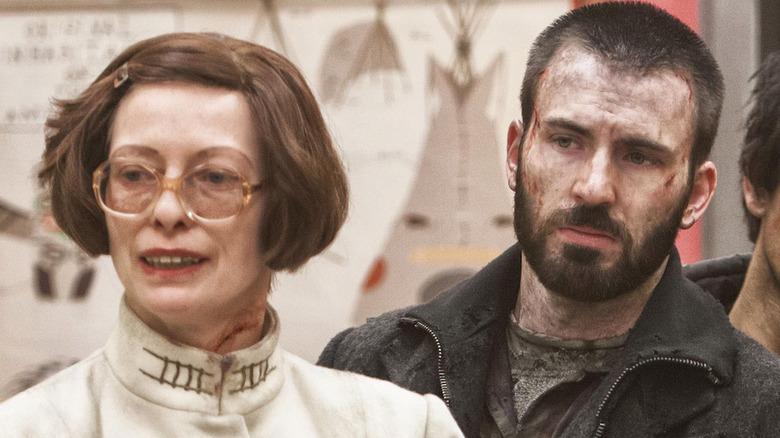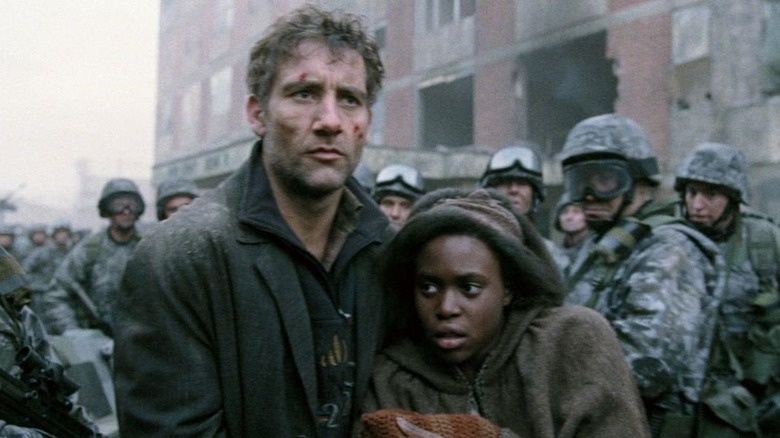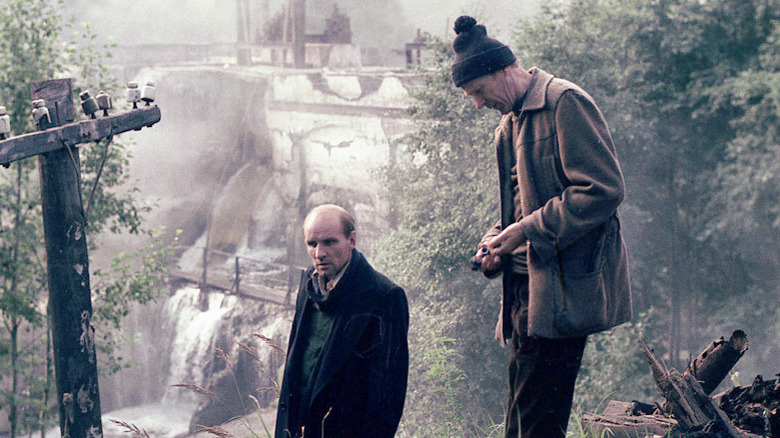Underrated Post-Apocalyptic Movies You Need To Watch
There's a wide array of movies showcasing the end of the world and the surviving population's struggle to adapt to their new desolate environment. From zombie films to movies that show the Earth devastated by nuclear war and overrun by hyper-violent, leather-clad bikers, the post-apocalyptic genre has been explored in dozens upon dozens of films, TV shows, and video games over the years.
The subgenre's most noteworthy and popular examples — such as "The Road," "Escape from New York," and the "Mad Max" series — are extremely well known. But like any cinematic genre, there are bound to be a few films that unfortunately fail to gain significant attention from worldwide audiences and go unnoticed compared to other, more successful post-apocalyptic movies. They can't all be "Mad Max: Fury Road," after all.
Here are 20 of the most criminally underappreciated post-apocalyptic films we can think of. It's definitely worth pointing your eyeballs in each of their directions for roughly two hours each.
World War Z
Released in 2013, the Brad Pitt-starring "World War Z" offers a fresh, thrilling depiction of Earth spiraling out of control as the result of a massive zombie outbreak. In the film, Pitt plays a former United Nations investigator traveling across the world searching for a way to stop the zombie plague that threatens to wipe out humanity.
The most expensive zombie movie ever made at an estimated budget of $190 million, "World War Z" was a major gamble on Paramount's part. Fortunately, it paid off handsomely, grossing over $540 million at the box office. Even with some slight criticism aimed at the movie's lackluster climax and what The Guardian calls a "conventional" action storyline, most reviews praised the movie's suspense and Pitt's performance.
A review from Variety opines that "World War Z" has more in common with virus-oriented movies like "The China Syndrome" and "Contagion" than it does a traditional zombie movie, meaning it probably belongs in the subgenre of post-apocalyptic thriller, as opposed to post-apocalyptic horror.
The Rover
While this Australian post-apocalyptic movie isn't part of the "Mad Max" series, "The Rover" closely resembles the overall story and world of "Mad Max." It's essentially a futuristic Western set in a dystopian Outback where law and order no longer exist and only the most ruthless survive.
It's in this nightmarish landscape that a stoic, no-nonsense drifter (Guy Pearce) has his car stolen by a gang of thieves. Using one of the thieves' brothers (Robert Pattinson) as a hostage and reluctant guide, the drifter travels across the Land Down Under to find his car and punish those responsible for its theft.
One of the first indie movies to feature Pattinson after the conclusion of the "Twilight" saga, "The Rover" is a wonderful, depressing thriller that mixes post-apocalypse vibes with more traditional genres like Westerns and buddy movies — although it's most certainly not a buddy comedy. Critics praised Pearce and Pattinson's performances, with the Los Angeles Times saying that the movie is "a most impressive piece of filmmaking, tense and unrelenting, that chills the blood as well as the soul."
Escape from L.A.
John Carpenter's 1996 sequel to his 1981 cult classic "Escape from New York," "Escape from L.A." remains as commonly praised as it is panned by Carpenter fans and film critics. Set in a dystopian future where America is ruled by a fascist theocratic government, "Escape from L.A." returns Kurt Russell to the role of former black ops soldier turned outlaw Snake Plissken. This time, Snake is tasked with going into the penal island of Los Angeles and retrieving a powerful weapon before it falls into the wrong hands.
Opening to mixed reviews, "Escape from L.A." was a box office bomb, grossing about $25 million on a budget of $50 million. Still, some people have grown to appreciate the film, with Carpenter himself telling Creative Screenwriting "'Escape from L.A.' is better than the first movie. Ten times better. It's got more to it. It's more mature." Over the years, "Escape from L.A." has gained a cult following of fans who have praised the movie's tone and satirical nature. "Carpenter's satirical angle isn't as sharp as his 'They Live,' but he is actually trying to say something: about freedom, leadership, and celebrity culture," opined the A.V. Club.
Stake Land
Released on the tail end of the late-2000s zombie craze, "Stake Land" was a distinctly different sort of horror film for its era, going against the grain by folding zombie apocalypse tropes into a vampire film. It's also a movie that helped reestablish vampires as legitimately terrifying creatures, pushing back against their more romanticized depictions in the "Twilight" films.
After a vampiric plague ravages civilization, an orphaned teenage boy (Connor Paolo) accompanies an experienced vampire hunter (Nick Damici) to a supposed safe haven. Paolo's character, Martin, leans how to defend himself against the hordes of the undead along the way.
A little-known horror movie with a minimal budget of just $625,000, "Stake Land" was an unexpected success, taking some reviewers by surprise with its impressive quality. Roger Ebert called it "a good-looking, well-played and atmospheric apocalyptic vision," with the New York Times' Jeannette Catsoulis selecting the film as a NYT Critic's Pick.
Night of the Comet
The ultimate cult film, "Night of the Comet" is a 1984 B-movie that flawlessly blends comedy with horror. A comet wipes out most of Earth's population and turns the remainder of humanity into zombies. Only a handful of survivors remain to fight the undead, including two teenage girls (Catherine Mary Stewart and Kelli Maroney) who retreat to a local mall and go ... shopping. If you think that sounds a lot like the premise of 1978's "Dawn of the Dead," that's because it does, but bear with us...
"Night of the Comet" could've only been made in the '80s. It's full of big hair, arcade games, sinister scientists, and some hilarious one-liners. A relative success at the box office that grossed $14.4 million, "Night of the Comet" earned mostly positive reviews from critics and gained an inevitable cult following that, apparently, includes Joss Whedon, who cites "Night of the Comet" as one of his inspirations for "Buffy the Vampire Slayer." Variety describes it as a movie with "an entertaining, tongue-in-cheek flair that compensates for its absence in originality," and while that's hardly unqualified praise, it doesn't sound like condemnation either.
On the Beach
An earlier mainstream post-apocalyptic film, 1959's "On the Beach" capitalizes on Cold War paranoia and fear of all-out nuclear conflict, imagining a world where the entire northern hemisphere has been rendered uninhabitable from extensive nuclear fallout. One of the last safe havens is Australia, where the crew of a U.S. Navy submarine deals with the loss of their loved ones as the winds threaten to push the fallout south, which would put the final nail in humanity's proverbial coffin.
Directed by legendary filmmaker Stanley Kramer and starring Hollywood icons Gregory Peck and Ava Gardner, "On the Beach" is one of the most depressing movies on this list due to its downbeat ending and basis in reality. Released when fear of nuclear war was prevalent throughout much of the world, the film offers an unflinching look at what the true cost of World War III would be — mankind itself doomed to extinction.
"On the Beach" received a large number of positive reviews upon release, earning a BAFTA for best director, a Golden Globe for best original score, and Academy Award nominations for best music and best film editing. "The great merit of this picture ... is the fact that it carries a passionate conviction that man is worth saving, after all," wrote The New York Times.
Z for Zachariah
After a mysterious nuclear apocalypse wipes out almost all life on Earth, three survivors (Margot Robbie, Chiwetel Ejiofor, and Chris Pine) spend their days living on an isolated farm. Their post-civilization existence culminates in a budding love triangle that boils over into potentially murderous levels of jealousy.
A fascinating study about relationships in hostile environments, "Z for Zachariah" examines the effects of isolation and how possessive individuals can become when they suspect their romantic relationships are threatened by an outside party. Much of the movie is left ambiguous, especially its ending, which leaves plenty of room for audience interpretation.
The film may have failed to attract significant mainstream attention, but still managed to draw in significantly positive reviews, with particular praise for the cast. "While the film isn't without a few tonal flaws, the performances — particularly Robbie's — keep the story grounded in a sublime, post-apocalyptic reality," said IGN.
Dredd
Out of the two cinematic adaptations of John Wagner's Judge Dredd character who originally appeared in the pages of "2000 AD," "Dredd" is much more faithful than the critically panned 1995 film starring Sylvester Stallone.
In this 2012 dark superhero movie, Karl Urban slips on the domed helmet of the titular character — a law-enforcement officer who acts as judge, jury, and executioner in the dystopian police state of Mega-City One. Joined by a rookie new recruit (Olivia Thirlby), Dredd finds himself locked in a tall building with dozens of dangerous criminals and no hope of backup arriving any time soon.
Upon its release, "Dredd" received largely positive reviews, particularly for its action, visuals, performances, and general faithfulness to the comics. "Grim, gritty, and ultra-violent, 'Dredd' reinstates the somber brutality missing from the U.K. comic book icon's previous screen outing,'" said Variety. Unfortunately, the movie tanked at the box office, reportedly grossing around $41.5 million on a budget of $50 million.
The Battery
"The Battery" was made on a ridiculously small budget of just about $6,000, proving that when it comes to making a good film, how much money you have at your disposal isn't as important as how well you use your available resources.
Directed by Jeremy Gardner, who co-stars along with a largely unknown cast, "The Battery" follows two former baseball players journeying through a zombie-ridden New England. Their differing personalities result in increasing tension as they try to survive wave after wave of ravenous zombies.
Since its release in 2014, "The Battery" has remained a fairly unknown horror-thriller examining trust and friendship amid the zombie apocalypse. It's stayed under the radar despite positive reviews from horror-centric outlets and winning several awards at international film festivals. "There is very little gore, there is very little action — however the cinematic quality and the emotionally charged atmosphere are sculpted in the right manner," said Bloody Disgusting.
The Last Man on Earth
Horror icon Vincent Price made no shortage of underrated movies throughout his career. His lesser-known hits include Roger Corman's "The Pit and the Pendulum" and the stylistic '70s cult classic "Theater of Blood." One of Price's most frequently overlooked but thoroughly enjoyable films is 1964's "The Last Man on Earth."
The first film adaptation of Richard Matheson's novel "I Am Legend," "The Last Man on Earth" stars Price as a scientist who is immune to a virus that has turned almost all of humanity into vampire-like creatures.
It takes a heck of a performance to single-handedly maintain an audience's interest for an hour and a half. Luckily, Price had talent to spare. While Price isn't the only actor in the movie, "The Last Man on Earth" still gives him a chance to flex his versatile acting muscles, playing a far more sympathetic role than the sinister figures he's typically associated with. The Austin Chronicle referred to "The Last Man on Earth" as "a chilling study of loneliness and an acting tour de force for Price as the last survivor of a dead race."
Day of the Dead
George Romero's first two entries in the "Night of the Living Dead" series are undisputed horror classics. In 1968's "Night of the Living Dead" and its 1978 sequel "Dawn of the Dead," Romero created the template for modern zombie films, redefining the zombie genre and influencing every other zombie-related film, TV show, comic, or video game that came after.
While Romero's third entry in the "Living Dead" series, 1985's "Day of the Dead," tends to get overshadowed by its predecessors, it's still an inventive zombie movie and one of Romero's most underrated works.
Taking place months after nearly the entire world's population have become zombies, "Day of the Dead" focuses on a group of scientists stationed at a military facility in Florida attempting to find a way for mankind to survive. The researchers come into conflict with the increasingly unhinged soldiers guarding the facility.
Like Romero's previous "Living Dead" movies, "Day of the Dead" was a box office success when released in 1985, grossing $34.4 million on a budget of $3.5 million. However, some critics felt the movie failed to live up to the standards of "Night of the Living Dead" and "Dawn of the Dead," with The Dissolve calling it "disappointing." Other critics found the film to be a memorable depiction of a post-apocalyptic Florida, and a fitting enough conclusion to Romero's zombie series — which it was, up until 2005's "Land of the Dead."
Turbo Kid
Set in a dystopian alternate history version of 1997, "Turbo Kid" follows The Kid (Munro Chambers) — a teenage comic book nerd and superhero — as he combats a tyrannical warlord (Michael Ironside) who uses a device to turn people into water.
An '80s-esque presentation of Earth following an apocalypse, "Turbo Kid" feels like a more lighthearted cross between "Escape from New York," the "Mad Max" series, "Kung Fury," and the music video for My Chemical Romance's "Na Na Na." It's a unique superhero movie that provides plenty of laughs and some first-rate action reminiscent of classic John Carpenter films, right down to the synth-heavy soundtrack. However, the movie isn't all fun and fancy; there are more than a few downbeat moments that reflect the more serious nature of its settings, such as the extreme and shocking violence and the cruelty certain individuals are capable of inflicting in the name of survival. Juxtaposed with such grim surroundings is the young superhero's quest to do right, as well as the story of his first love with another teenaged survivor-slash-hardcore comic book fan.
"'It's a satire to be sure, but one that embraces its retro origins with an exuberance that is as much fun as it is nostalgic," said the Austin Chronicle.
It Comes at Night
After a highly contagious disease spreads throughout the world, a small family comprised of a husband and wife (Joel Edgerton and Carmen Ejogo) and their son (Kelvin Harrison Jr.) live in an isolated cabin deep in the forest. When the family encounters other survivors, they must decide whether to invite them in and risk exposure or send them away and fend for themselves.
Writer-director Trey Edward Shults may be better known for family dramas like "Waves" and "Krisha," but his inclination to explore family dynamics works well within the context of this horror movie that leaves you wondering just how far you're willing to go to protect your family.
A financial success earning $19.7 million on a budget of $5 million, "It Comes at Night" generated significant critical buzz, with publications like RogerEbert.com naming it "one of the most terrifying films in years." The website went on to say, "In a sense, it's a reverse horror film, one that tells us, 'Sure, the outside world is scary, but it's distrust and paranoia that will truly be your undoing.'"
10 Cloverfield Lane
When "10 Cloverfield Lane" hit theaters in 2016, it was an unexpected surprise for a variety of reasons. First and foremost, the film's ending revealed its connection to 2008's highly popular "Cloverfield," establishing a cinematic universe filled with colossal extraterrestrial monsters and setting the stage for 2018's "The Cloverfield Paradox." Aside from that, the movie also boasted some incredible performances from its relatively small cast, particularly stars Mary Elizabeth Winstead and John Goodman.
Winstead plays Michelle, a young woman who wakes up after a car accident and finds herself locked in a bunker with two men who inform her that the world has ended. As she gets used to her new life underground, Michelle slowly begins to grow suspicious of the actual status of the world outside, and whether the men's intentions are as honorable as they initially seemed.
Taken as a whole, "10 Cloverfield Lane" feels like a feature length episode of "The Twilight Zone" — it's ominous, foreboding, and punctuated by plot twists that keep you guessing about the characters' motivations. A financial and critical success earning $110.2 million, "10 Cloverfield Lane" garnered praise from publications like Variety, who said the film's "tension is rooted in psychology rather than gimmickry and evinces a command of craft that feels old-fashioned in the most refreshing possible sense."
Delicatessen
Most people don't tend to think of post-apocalyptic movies as funny. The subgenre is tailored more for horror or action than it is for comedy. However, every once in a while, an off-kilter post-apocalyptic movie comes along that depicts life following the end of civilization in a humorous light. While the mainstream population is already aware of "Shaun of the Dead," fewer folks have seen the 1991 French dark comedy, "Delicatessen."
Years after an event leaves society in shambles, food is a rare commodity. To solve this problem, a landlord (Jean-Claude Dreyfus) advertises employment at his rundown apartment complex, killing the would-be employee and using him as a cheap source of meat. All this changes when a former circus clown (Dominique Pinon) comes to town looking for a job and ends up falling in love with the landlord's musically inclined daughter (Marie-Laure Dougnac).
Co-directed by Jean-Pierre Jeunut — the brains behind the critically acclaimed "Amélie" and the misunderstood "Alien: Resurrection" — "Delicatessen" is a funny and surreal film that provides more laughs than thrills or chills. "Beautifully textured, cleverly scripted and eerily shot ... 'Delicatessen' is a zany little film," said Variety.
Dawn of the Planet of the Apes
An argument could be made that numerous "Planet of the Apes" movies deserve a place on this list. But in terms of overall quality and storytelling, few entries in the series surpass 2014's "Dawn of the Planet of the Apes."
A few years after the events of "Rise of the Planet of the Apes," most of humanity has perished as a result of the contagious Simian Flu. What few survivors remain gather in the ruins of decrepit cities like San Francisco, coming into contact with a tribe of intelligent apes led by Caesar (Andy Serkis) in the process.
Epic in scope and practically Shakespearean in its story, "Dawn of the Planet of the Apes" follows up "Rise" by showcasing the increasing intelligence of the apes and the power struggles within both human and ape factions. "Dawn" was a major blockbuster success in the mid-2010s, grossing more than $710 million. "In the annals of sequels, 'Dawn' is to 'Rise of the Planet of the Apes' what 'The Empire Strikes Back' was to 'Star Wars' — it's that much better," said The Hollywood Reporter.
La Jetée
Hardcore post-apocalyptic movie fans are likely to have heard of Terry Gilliam's contribution to the genre — "12 Monkeys." However, the film that inspired "12 Monkeys" — 1962's French avant-garde short film, "La Jetée" — is decidedly less well known. In the wake of a nuclear war, Paris is a bombed-out wasteland with a population living underground. Scientists devise a way to send its citizens back in time to prevent their dismal future, ultimately choosing a man (Jean Négroni) who must relive his childhood memories to save his present.
"La Jetée" uses minimalist filmmaking techniques to advance its story and depict its post-apocalyptic settings — relying on still images of its post-nuclear war dystopian future. Though the film had a dramatically smaller budget and runtime than "12 Monkeys," "La Jetée" is every bit as entertaining as Gilliam's award-winning 1995 movie.
"The bittersweet music, the narrator's steady voice that sounds like a scientist's, the museum-quality photos, and the gripping plot all make 'La Jetée' an inimitable experience," said the San Francisco Chronicle.
Snowpiercer
Before his Oscar-winning exploration of inequality, 2019's "Parasite," director Bong Joon-ho tackled similar topics from completely different angles in his previous movies. One of these previous movies would be "Snowpiercer," the Chris Evans-starring vehicle set in a near future where a man-made ice age has rendered all of Earth's surface uninhabitable. The remaining human population travel aboard a train — the titular "Snowpiercer" — that never stops moving across the globe.
After nearly two decades aboard the train, the survivors have been organized into different social classes. The underfed lower-class passengers attempt to rise up against their elite oppressors.
Bong Joon-ho has a knack for analyzing topical subject matter in genre pieces, as is evident from 2006's "The Host" and 2017's "Okja." In 2013's "Snowpiercer," the director once again touches upon weighty themes and subjects, this time depicting the inherent struggles between social classes.
Aside from its brutal satire, the movie includes some incredible action and fantastic performances from its huge cast, which includes Evans, Jamie Bell, Song Kang-ho, Tilda Swinton, Octavia Spencer, John Hurt, and Ed Harris. According to Entertainment Weekly, "'Snowpiercer' sucks you into its strange, brave new world so completely that it leaves you with the all-too-rare sensation that you've just witnessed something you've never seen before ... and need to see again."
Children of Men
Alfonso Cuarón is seemingly incapable of making a bad movie. Whether he's putting together a dystopian story or a "Harry Potter" movie, Cuarón always manages to inject his own distinct style into his projects, as exemplified by his critically acclaimed 2006 film, "Children of Men."
In the near future, a bizarre worldwide health issue prevents women from having babies, plunging the world into chaos and uncertainty regarding mankind's future existence. When a young refugee woman (Clare-Hope Ashitey) finds herself miraculously pregnant, a group of activists agree to guide her to sanctuary across a fascist England.
Perhaps in part due to its limited theatrical release, "Children of Men" failed to become a box office success, grossing $70 million worldwide on a budget of $76 million. Despite its initial commercial disappointment, the movie still earned overwhelmingly positive reviews, was nominated for three Academy Awards, and won two out of the three BAFTAs categories it was nominated for.
In 2016, "Children of Men" was voted the 13th greatest film of the 21st century by the BBC. Meanwhile, Rolling Stone named the movie the second-best film of the 2000s, with the writer declaring "No movie this decade was more redolent of sorrowful beauty and exhilarating action."
Stalker
In a strange, distant future, the middle of an unpopulated region known as the "Zone" contains a room that can supposedly grant you your deepest wishes. That's the basic premise of "Stalker," the 1979 science fiction film by Andrei Tarkovsky, in which a guide leads two men through the mysterious "Zone" so that their wishes can be fulfilled.
Sparse in everything from dialogue to its post-apocalyptic presentation, "Stalker" focuses more intently on the philosophy, theology, and psychology of its characters than it does its dystopian settings. There are no raiders or flesh-eating zombies creeping around, but it does makes you feel an increasingly poignant sense of unease throughout its nearly three-hour runtime, as the characters gradually draw closer to their fabled destination.
"Stalker" failed to garner positive reviews upon its initial release but has since gained an esteemed reputation in the filmgoing community. The British Film Institute's Sight & Sound magazine listed it on their list of the 100 greatest films of all time, and the movie also received high scores on Rotten Tomatoes and IMDb. "There are no flying saucers in the great Russian director's haunting tale of a journey into the depths of a post-apocalyptic landscape, but it offers visual splendor, as well as mysteries, portents and miracles," said the Wall Street Journal.
